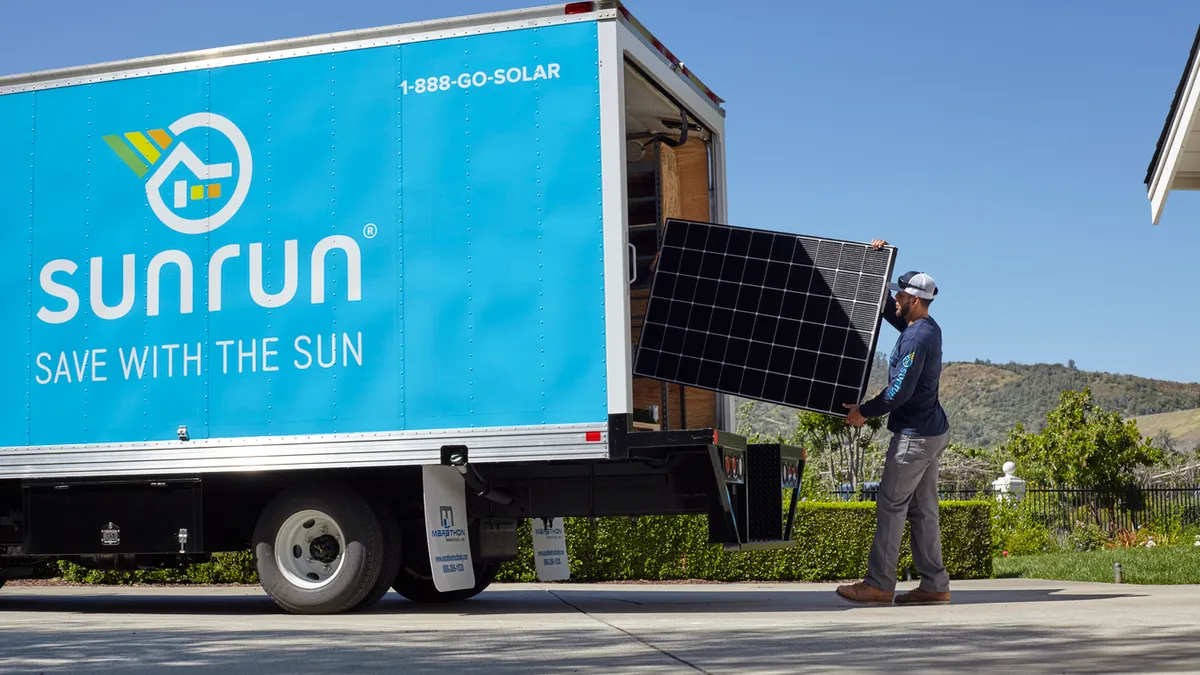2019 has been a huge year of firsts for the distributed resource industry: It saw the first aggregated solar and storage systems to win a bid in the wholesale market (in ISO-New England) and the first utility to reward homeowners for letting their battery systems be used for frequency services (in Hawaiian Electric Company territory).
Both of those projects involve Sunrun, and it's not a surprise.
The developer has been working to identify as many different types of partnerships and revenue streams from aggregated DER as possible. Oftentimes, Sunrun is focused on making space for itself and other solar developers in the ongoing grid transformation to ensure that DERs can compete against traditional generation.
"These rules are really written for power plants, and so how do we alter them so that customer-sided resources can participate?" Audrey Lee, Sunrun's energy services vice president, told Utility Dive. "The ISO New England market is like a 30 GW market, there's plenty of room for distributed resources ... It's more about changing the market rules."
"There's a difference between a technical requirement and a piece of equipment, and creating the market structure to actually compensate customers for participating."

Audrey Lee
Energy Services Vice President, Sunrun
Sunrun won a bid in ISO-NE for 20 MW of aggregated distributed solar-plus-storage in Massachusetts.
"There's not a lot of utility RFPs on the mainland for frequency response," Lee said.
The developer has also been looking at similar applications to the Hawaii project in Oahu, Puerto Rico and other island grids.
"We will be using the smart inverters to help HECO maintain frequency on the grid [at 60 Hertz]," Lee said. Other companies had used battery storage or smart inverters for frequency regulation, but utilities don't typically compensate customers and developers for that service.
"There's a difference between a technical requirement and a piece of equipment, and creating the market structure to actually compensate customers for participating," she said.
As a market leader in residential solar, Sunrun has continuously grown its customer base.

According to its third quarter results, the utility has deployed more than 296 MW of energy so far, for a cumulative deployment of more than 1,870 MW.
Another new business strategy has involved solar deployment with community choice aggregators in California.
Sunrun announced its first longterm contract with a CCA this summer, following up on a 2018 goal to target more low-income, multi-unit homes with its deployments. The company is building a 500 kW project for low-income, multi-unit housing, along with more than 2 MWh of batteries, per a new agreement with East Bay Community Energy.
"Given the growing prevalence of community choice aggregators in California, this was an important precedent for us to set as well, to show that this can be done with CCAs ... to provide them local and clean energy capacity.
"The next great area of growth for these BYO-type programs is going to be inverter-based technologies, with storage and solar and a combination thereof."

Jen Szaro
Vice President, SEPA
But besides steadily increasing solar deployment, the company has become focused on incorporating battery storage in its Brightbox offerings in areas of the country that face a lot of power outages. Deployments for Brightbox have increased in Texas, where the company offers a virtual net energy metering product, given the hot summer weather that has prompted outages during the summer.
Sunrun has also partnered with utilities like National Grid and Green Mountain Power to encourage bring-your-own (BYO) device programs for distributed energy. Utilities facing gas constraints in the Northeast have been looking more to distributed resources such as battery storage, but Sunrun has prioritized working on grid interconnection to enable more developers to compete.
"The next great area of growth for these BYO-type programs is going to be inverter-based technologies, with storage and solar and a combination thereof," Jen Szaro, vice president of the Smart Electric Power Alliance, told Utility Dive.
While BYO programs have seen success in the Northeast, "we're working to expand that to other utilities and take it as a model," Lee said.
The developer has spread the word about the East Coast BYO-battery model this year in several jursidictions, including a workshop in October with the California Public Utilities Commission.
"Let's get these inverter-based technologies standards down," so that BYO-microgrid "can be the next big thing," Szaro said.
The idea of a BYO-microgrid appeals to Sunrun as the company has worked to prove the resiliency of its model by deploying Brightbox in areas like Puerto Rico, which faced extreme periods of blackouts following the damage from Hurricane Maria in 2017, and California, which has been devastated by wildfires in the past three years.
"Power prices are really high and the [Puerto Rico] grid can be quite fragile, so there's a great opportunity as well to network the solar and batteries that we're putting there and provide it as a virtual power plant in Puerto Rico," Lee said.
CORRECTION: A previous version of this article misidentified SEPA. It's the Smart Electric Power Alliance.




 Read more
Read more









